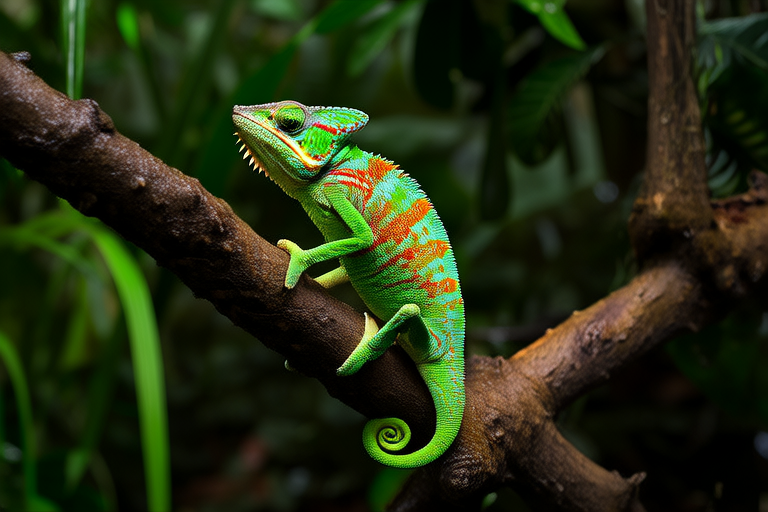From Jungle to Home: A Comprehensive Guide to Caring for Chameleons
Welcome to the fascinating world of chameleons! These unique reptiles, known for their ability to change colors and their independently rotating eyes, have captured the hearts of many animal lovers. If you’re considering bringing one of these exotic creatures into your home, this guide will provide you with all the essential information to ensure your chameleon thrives in its new environment.
Habitat Setup: Creating a Jungle-like Environment
Creating an ideal habitat for your chameleon is crucial. Mimicking their natural environment as closely as possible will help them feel at home and stay healthy.
Lighting
Chameleons require full-spectrum UVB lighting to synthesize vitamin D3, which aids in calcium absorption. Choose a high-quality UVB bulb designed for reptiles and position it so that it covers approximately 70% of the enclosure. Replace the bulb every six months, even if it still seems functional, to ensure it continues providing adequate UVB light.
Temperature
Chameleons are ectothermic, meaning they rely on external heat sources to regulate their body temperature. Maintain a temperature gradient within the enclosure, ranging from 75°F to 95°F during the day and slightly cooler at night. Use thermometers placed at various points within the enclosure to monitor temperatures accurately.
Humidity
Most chameleon species thrive in environments with moderate to high humidity levels, typically between 40% and 70%. Regular misting of the enclosure helps maintain appropriate humidity levels. Consider using an automatic misting system or humidifiers if necessary.
Diet and Feeding
A well-balanced diet is vital for your chameleon’s health and longevity. Insects such as crickets, dubia roaches, and silkworms are commonly fed to chameleons. Dust the insects with a calcium supplement without vitamin D3 two to three times per week and with a multivitamin once weekly.
Offer a variety of insects to provide a broad spectrum of nutrients. Ensure that the insects are gut-loaded before feeding them to your chameleon. Gut-loading involves feeding the insects a nutritious diet rich in vitamins and minerals for 24 to 48 hours before offering them to your chameleon.
Health Concerns
Regular veterinary check-ups are essential for early detection and treatment of potential health issues. Common health problems include metabolic bone disease (MBD) due to calcium deficiency, respiratory infections, and parasites.
Monitor your chameleon closely for any signs of illness, such as lethargy, loss of appetite, swollen limbs, or discharge from the eyes or nose. Prompt action can prevent minor issues from becoming serious health threats.
Behavioral Insights
Understanding chameleon behavior is key to providing a stimulating and enriching environment. Chameleons are solitary animals and prefer to be alone. Aggression towards other chameleons can lead to stress and injury.
These reptiles are arboreal, meaning they spend most of their time in trees. Provide plenty of branches and foliage for climbing and hiding. Encourage natural behaviors by setting up a climbing structure that mimics their natural habitat.
Tips for Choosing the Right Species
Choosing the right species is important to ensure compatibility with your lifestyle and resources. Some popular choices include veiled chameleons, panther chameleons, and Jackson’s chameleons. Research each species’ specific needs, lifespan, and temperament before making a decision.
Common Mistakes to Avoid
Avoid overcrowding the enclosure with too many decorations, which can limit space and hinder proper airflow. Overfeeding or underfeeding can also lead to health issues. Always provide fresh water daily and clean the enclosure regularly to prevent the buildup of harmful bacteria.
Maintaining a Healthy Environment
To keep your chameleon’s environment clean and healthy, remove uneaten food promptly and clean the enclosure thoroughly at least once a month. Use mild, pet-safe disinfectants and rinse all surfaces thoroughly before replacing substrates and decorations.
Provide a variety of foliage for climbing and hiding. Ensure that all branches and decorations are securely fastened to prevent accidents. Regularly inspect the enclosure for any signs of wear or damage that could compromise safety.
Conclusion
Caring for a chameleon requires dedication and commitment but can be incredibly rewarding. By understanding their unique needs and providing a suitable environment, you can ensure that your chameleon lives a long and healthy life. With patience and care, you’ll be rewarded with the company of one of nature’s most fascinating creatures.
